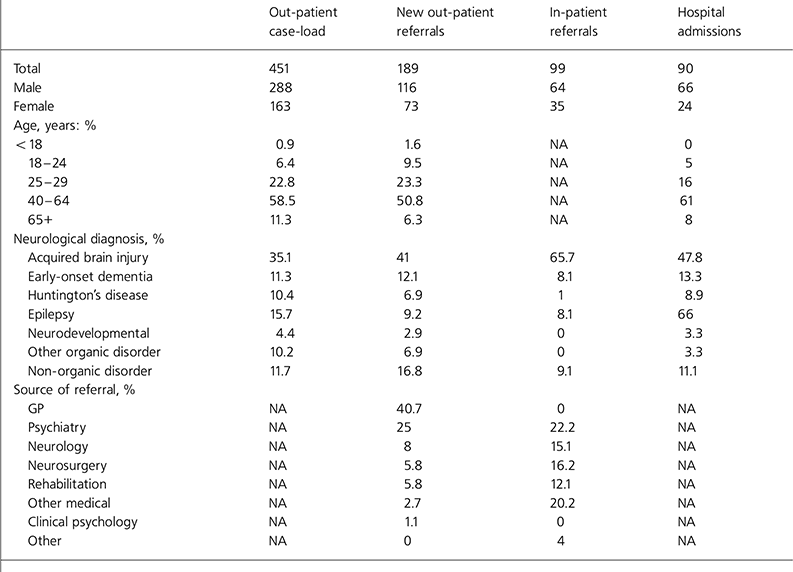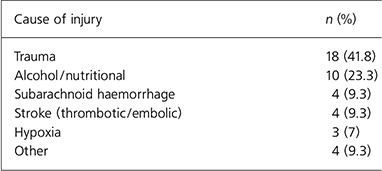Neuropsychiatry as a sub-specialty was formally recognised by the Royal College of Psychiatrists in 2001 with the creation of a College special interest group. The group has drawn together clinicians working in many different settings and although some specialise in single diagnostic groups such as epilepsy or brain injury, others manage a wide range of neurological diagnoses. What is the demand for such services and what do they do? The first person to address this was Alwyn Lishman who, in a presentation to the British Neuropsychiatry Association, described the range of referrals to his service at the Maudsley Hospital, a national and international centre (Reference LishmanLishman, 1992). More recently, Leonard et al (Reference Leonard, Majid and Sivakumark2002) described a monthly outreach clinic at the Maudsley Hospital. Scheepers et al (Reference Scheepers, Bird and Rogers1995) reported 6 months of out-patient referrals and admissions to the Burden Neurological Hospital in Bristol. The Burden was established over a half a century ago and has an international reputation for neurophysiology research. The clinical service is regional rather than district and manages a wide range of disorders. However, epilepsy and movement disorders predominate, reflecting the interest of the local clinicians.
What is the demand for local neuropsychiatric services? This paper attempts to answer this question. It describes the activity of a busy and comprehensive district neuropsychiatry service over a 1-year period.
Service origins and composition
The North Staffordshire Neuropsychiatry Service is unusual in the range of disorders covered and in the fact that it was established over a decade ago. North Staffordshire has a population of approximately half a million and is a sub-regional centre for neurology, neurosurgery, rehabilitation medicine and a range of other specialties. This is a mixed urban and rural district and approximately 300 000 people live in the conurbation of Stoke-on-Trent and Newcastle-under-Lyme.
The North Staffordshire Neuropsychiatry Service began as a monthly special interest clinic in January 1987. The service grew steadily from those modest origins, and at the time of writing employs 1.5 consultants and over 30 nurses (including community nurses) and has dedicated sessions from speech and language therapists, physiotherapists and occupational therapists. There are 25 beds, including a 10-bed assessment unit and a 15-bed rehabilitation and planned short-stay unit. There is a well-established neuropsychology service in the district, including specialists in acquired brain injury.
It is beyond the scope of this paper to describe in detail how the service evolved to its present size, but some key stages will be noted. The beds within the service were initially within a large mental hospital. Two wards were dedicated to people with neuropsychiatric disorders and these were re-located within the same trust following the closure of that hospital. A 5-year grant from the Department of Health in the early 1990s, to assist with the development of brain injury services, was another key factor. Local demand for the service led to increased waiting times for clinics.
In 2001, a major rebuilding scheme was completed and the old mental hospital was closed. This new service included a ten-bed acute neuropsychiatry unit adjacent to the general hospital but on a mental health campus. The service was established before general psychiatry services were split into sectors based on geography. This has meant that many individuals who traditionally remain on acute psychiatry wards (e.g. people with brain injury, Huntington’s disease and early-onset dementia) have their own specialist provision.
Method
Diagnostic groupings
The neuropsychiatry service maintains a clinical database for audit purposes. This includes diagnostic categories, age, gender, date of referral and source of referral. Diagnostic categories include: acquired brain injury (including all single insult causes – trauma, haemorrhage, infection etc.), Huntington’s disease, early-onset dementia (differentiated from Huntington’s disease since severe cognitive impairment is usually a late feature of that disorder), epilepsy, developmental disorders, other neurological disorders (including Parkinson’s disease, multiple sclerosis etc.) and non-organic disorders. Psychiatric syndromes treated by the service are to be the subject of a separate inquiry but it is worth noting that several such syndromes may develop in a single individual over time, particularly during recovery from brain injury or in the course of brain degeneration.
Data covering a 1-year period (1 October 2001 to 30 September 2002) are presented. The types of contact included are new out-patient referrals, general hospital/liaison consultations and hospital admissions. A breakdown of the total out-patient case-load of the service is also included. Age distribution of in-patient referrals, source of referral for admission and source of referral of the total out-patient case-load were not recorded.
Results
New out-patient referrals, in-patient referrals, out-patient case-load and hospital admissions are shown in Table 1. In-patients with acquired brain injury are listed according to cause of injury in Table 2.
Table 1. Data on out-patient case-load, new referrals, in-patient referrals and admissions

| Out-patient case-load | New out-patient referrals | In-patient referrals | Hospital admissions | |
|---|---|---|---|---|
| Total | 451 | 189 | 99 | 90 |
| Male | 288 | 116 | 64 | 66 |
| Female | 163 | 73 | 35 | 24 |
| Age, years: % | ||||
| < 18 | 0.9 | 1.6 | NA | 0 |
| 18-24 | 6.4 | 9.5 | NA | 5 |
| 25-29 | 22.8 | 23.3 | NA | 16 |
| 40-64 | 58.5 | 50.8 | NA | 61 |
| 65+ | 11.3 | 6.3 | NA | 8 |
| Neurological diagnosis, % | ||||
| Acquired brain injury | 35.1 | 41 | 65.7 | 47.8 |
| Early-onset dementia | 11.3 | 12.1 | 8.1 | 13.3 |
| Huntington’s disease | 10.4 | 6.9 | 1 | 8.9 |
| Epilepsy | 15.7 | 9.2 | 8.1 | 66 |
| Neurodevelopmental | 4.4 | 2.9 | 0 | 3.3 |
| Other organic disorder | 10.2 | 6.9 | 0 | 3.3 |
| Non-organic disorder | 11.7 | 16.8 | 9.1 | 11.1 |
| Source of referral, % | ||||
| GP | NA | 40.7 | 0 | NA |
| Psychiatry | NA | 25 | 22.2 | NA |
| Neurology | NA | 8 | 15.1 | NA |
| Neurosurgery | NA | 5.8 | 16.2 | NA |
| Rehabilitation | NA | 5.8 | 12.1 | NA |
| Other medical | NA | 2.7 | 20.2 | NA |
| Clinical psychology | NA | 1.1 | 0 | NA |
| Other | NA | 0 | 4 | NA |
Table 2. Breakdown of brain injury admissions (n=43) by cause of injury

| Cause of injury | n (%) |
|---|---|
| Trauma | 18 (41.8) |
| Alcohol/nutritional | 10 (23.3) |
| Subarachnoid haemorrhage | 4 (9.3) |
| Stroke (thrombotic/embolic) | 4 (9.3) |
| Hypoxia | 3 (7) |
| Other | 4 (9.3) |
Discussion
This paper describes the work of a busy, well-established district neuropsychiatry service. Although the service is not directly comparable to the Bristol service described by Scheepers et al (Reference Scheepers, Bird and Rogers1995) there are some common features. The highly specialist nature of these services might lead one to consider them tertiary, but a high proportion of referrals are from primary care (46.3% in North Staffordshire, 77% in Bristol). The relatively high proportion of referrals with acquired brain injury reflects the fact that this is the most established component of the service and in some respects the most innovative. Early referral and admission following brain injury generally obviates the need for major tranquillisers to quell difficult behaviour in this group, a common practice on neurosurgical units. It is perhaps relevant that over the past decade only one patient with brain injury from this district has required referral to a private sector brain injury behavioural unit, a rare case of hyperphagia and personality change following surgery for craniopharyngioma.
People with Huntington’s disease associated with psychiatric disorder have been managed by the service since the 1980s but a more comprehensive approach was adopted in the mid 1990s. This has included pre-symptomatic genetic testing, which has revealed a high prevalence of the disorder in North Staffordshire (over 10 in 100 000).
Data on the source of admissions were not retained but most were transfers from other wards, particularly individuals with brain injury. The relatively large number of admissions reflects the demand for the service and its importance in ‘freeing’ acute neurosurgery, neurology and medical beds. The latter was important in our commissioners’ decision to provide continuing funds when our Department of Health brain injury grant came to an end.
Most of the funding for the service now comes from the four primary care trusts that serve North Staffordshire; when the service began in the late 1980s there was a single health authority for the district. Although the majority of patients managed by the service live in North Staffordshire, approximately 15% are from outside the district, mostly from adjacent primary care trusts. The number of out-of-district referrals has increased yearly, particularly those with acquired brain injury and Huntington’s disease.
A significant number of individuals did not have brain disease but presented with neurological symptoms as part of a dissociative or somatisation disorder. Referrals of those with neurodevelopmental problems have steadily increased, and this has recently led to the creation of a joint consultant appointment with the local learning disabilities service.
In conclusion, the title of this paper posed the question: is there a market out there for neuropsychiatry? This field trial indicates that the answer is ‘yes’.
Acknowledgement
This paper is based on a presentation to the British Neuropsychiatry Association in February 2003.







eLetters
No eLetters have been published for this article.